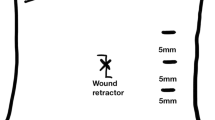Abstract
Purpose
The aim of this study was to elucidate the prevalence of urachal remnants in children in relation to patient age as well as to identify their anatomic variants, using a laparoscopic view.
Methods
The medical records of 394 pediatric patients who underwent laparoscopic inguinal hernia repair were reviewed. Patients were divided into four groups based on their age at surgery. Using laparoscopic visualization, the presence and anatomic variants of urachal remnants were analyzed.
Results
A urachal remnant was confirmed in 140 children (35.5%). Although the prevalence was significantly higher in the group of children aged < 1 year (63.2%) than in any other group, no significant difference in the prevalence was observed between the groups aged ≥ 1 year. In 42 cases (10.7%), the urachal remnant merged into the lateral umbilical ligament.
Conclusions
Our results suggest a recommendation of nonoperative management of asymptomatic urachal remnants, especially in patients less than 1 year of age due to its probable spontaneous resolution. Knowledge of the anatomic variants could improve the accuracy of diagnosis of urachal remnants and the comprehension of its structure and localization for the achievement of accurate and complete excision.



Similar content being viewed by others
References
Blichert-Toft M, Koch F, Nielsen OV (1973) Anatomic variants of the urachus related to clinical appearance and surgical treatment of urachal lesions. Surg Gynecol Obstet 137:51–54
McCollum MO, Macneily AE, Blair GK (2003) Surgical implications of urachal remnants: presentation and management. J Pediatr Surg 38:798–803
Ashley RA, Inman BA, Routh JC, Rohlinger AL, Husmann DA, Kramer SA (2007) Urachal anomalies: a longitudinal study of urachal remnants in children and adults. J Urol 178:1615–1618
Gleason JM, Bowlin PR, Bagli DJ, Lorenzo AJ, Hassouna T, Koyle MA, Farhat WA (2015) A comprehensive review of pediatric urachal anomalies and predictive analysis for adult urachal adenocarcinoma. J Urol 193:632–636
Robert Y, Hennequin-Delerue C, Chaillet D, Dubrulle F, Biserte J, Lemaitre L (1996) Urachal remnants: sonographic assessment. J Clin Ultrasound 24:339–344
Widni EE, Hollwarth ME, Haxhija EQ (2010) The impact of preoperative ultrasound on correct diagnosis of urachal remnants in children. J Pediatr Surg 45:1433–1437
Yu JS, Kim KW, Lee HJ, Lee YJ, Yoon CS, Kim MJ (2001) Urachal remnant diseases: spectrum of CT and US findings. Radiographics 21:451–461
Ueno T, Hashimoto H, Yokoyama H, Ito M, Kouda K, Kanamaru H (2003) Urachal anomalies: ultrasonography and management. J Pediatr Surg 38:1203–1207
Galati VG, Donovan B, Ramji F (2008) Management of urachal remnants in early childhood. J Urol 180:1824–1827
Zieger B, Sokol B, Rohrschneider WK, Darge K, Tröger J (1998) Sonomorphology and involution of the normal urachus in asymptomatic newborns. Pediatr Radiol 28:156–161
Stopak JK, Azarow KS, Abdessalam SF, Raynor SC, Perry DA, Cusick RA (2015) Trends in surgical management of urachal anomalies. J Pediatr Surg 50:1334–1337
Sato H, Furuta S, Tsuji S, Kawase H, Kitagawa H (2015) The current strategy for urachal remnants. Pediatr Surg Int 31:581–587
Dethlefs CR, Abdessalam SF, Raynor SC, Perry DA, Allbery SM, Lyden ER, Azarow KS, Cusick RA (2019) Conservative management of urachal anomalies. J Pediatr Surg 54:1054–1058
Zenitani M, Saka R, Sasaki T, Takama Y, Tani G, Tanaka N, Ueno T, Tazuke Y, Oue T, Okuyama H (2019) Safety and efficacy of laparoscopic percutaneous extraperitoneal closure for inguinal hernia in infants younger than 6 months: a comparison with conventional open repair. Asian J Endosc Surg 12:439–445
Schubert GE, Pavkovic MB, Bethke-Bedürftig BA (1982) Tubular urachal remnants in adult bladders. J Urol 127:40–42
Pinthus JH, Haddad R, Trachtenberg J, Holowaty E, Bowler J, Herzenberg AM, Jewett M, Fleshner NE (2006) Population based survival data on urachal tumors. J Urol 175:2042–2047
Ceylan H, Sirikci A, Kilicaslan S, Gumusburun E (2003) An unusual localization of an infected urachal sinus. J Pediatr Surg 8:1117–1118
Boyle G, Rosenberg HK, O’Neill J (1988) An unusual presentation of an infected urachal cyst. Review of urachal anomalies. Clin Pediatr (Phila) 27:130–134
Kenigsberg K (1975) Infection of umbilical artery stimulating patent urachus. J Pediatr 86:151–152
Mackie GG, Zaitoon MM, Jequier S (1982) Umbilical artery sinus Rare cause of umbilical drainage. Urology 19:414–415
Acknowledgements
This work was supported by a Hyogo College of Medicine Grant for Research Promotion, 2020.
Author information
Authors and Affiliations
Contributions
Conception or design of the work: MZ; acquisition, analysis, or interpretation of data: MZ; drafting or revising of the manuscript: MZ, SN; final approval of the version to be published: TO. All authors reviewed the manuscript.
Corresponding author
Ethics declarations
Competing interests
The authors declare no competing interests.
Conflict of interest
The authors have no conflicts of interest associated with this manuscript.
Ethical standards
This study was approved by the Ethics Committees of Hyogo College of Medicine (IRB number: 3700).
Additional information
Publisher's Note
Springer Nature remains neutral with regard to jurisdictional claims in published maps and institutional affiliations.
Rights and permissions
About this article
Cite this article
Zenitani, M., Nose, S. & Oue, T. Prevalence of urachal remnants in children according to age and their anatomic variants. Pediatr Surg Int 38, 1495–1500 (2022). https://doi.org/10.1007/s00383-022-05183-2
Accepted:
Published:
Issue Date:
DOI: https://doi.org/10.1007/s00383-022-05183-2




